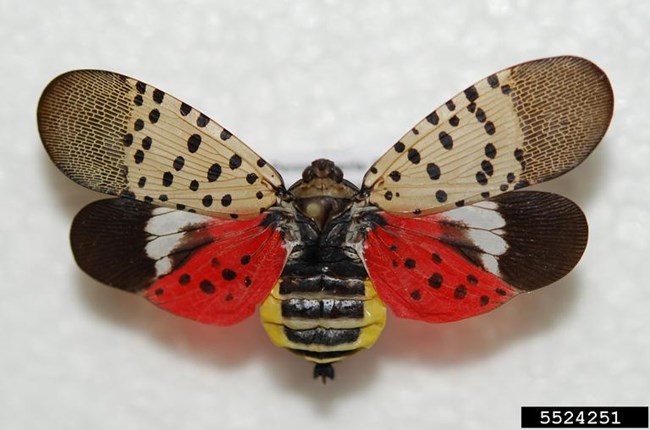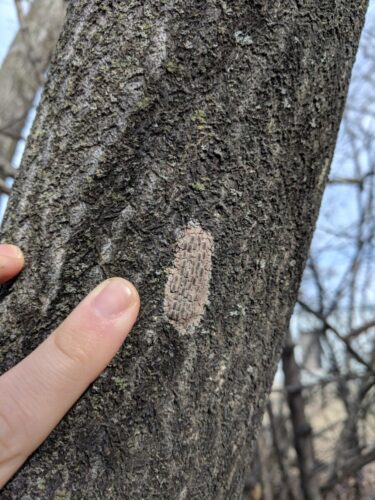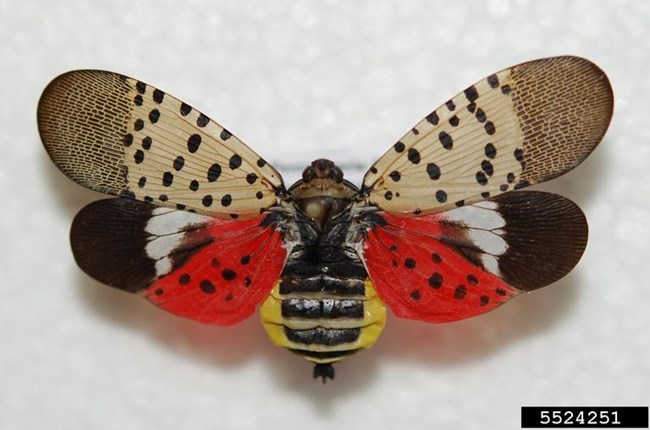The spotted lanternfly is a new threat to the US, and has already made its way to Charlottesville, VA, and surrounding areas. This invasive species, native to Asia, poses a significant risk to our local ecosystem, impacting crops in particular. Let’s explore the history of the spotted lanternfly, why it is so dangerous, and what steps you should take if you spot this pest in our community.
The History of the Spotted Lanternfly
The spotted lanternfly (Lycorma delicatula) was first discovered in the US in Pennsylvania in 2014. It likely arrived in the United States through international trade, hitching a ride on imported goods. Since its initial detection, this pest has spread rapidly across the northeastern United States, and sightings have been reported as far south as Virginia.
This insect is known for its striking appearance. Adult lanternflies are about one inch long, with distinctive gray wings adorned with black spots and a bright red underwing. While their appearance might be captivating, their impact on the environment is anything but.

Why the Spotted Lanternfly is Dangerous
The spotted lanternfly poses a severe threat to agriculture and forestry. Here’s why:
- Host Range: The lanternfly feeds on a wide variety of plants, including grapes, apples, stone fruits, and hardwood trees. This broad host range means it can cause extensive damage to both cultivated crops and natural forests.
- Feeding Damage: Spotted lanternflies use their piercing-sucking mouthparts to extract sap from plants. This feeding process weakens the plants, making them more susceptible to disease and other pests. Over time, heavy infestations can lead to reduced crop yields and even plant death.
- Honeydew and Sooty Mold: As lanternflies feed, they excrete a sugary substance known as honeydew. This honeydew promotes the growth of sooty mold, a black fungus that can cover leaves, stems, and fruit, further reducing the photosynthetic capability of the plants and making fruits unmarketable.
What to Do If You See a Spotted Lanternfly
Given the potential damage these insects can cause, it’s crucial to take immediate action if you spot a spotted lanternfly in Charlottesville or the surrounding areas. While the spotted lanternfly is currently quarantined in Virginia, there’s a chance that it could spread at any time. Here’s what you should do:
- Identify and Report: If you think you’ve spotted a lanternfly, take a photo and report the sighting to the Virginia Department of Agriculture and Consumer Services (VDACS). Accurate identification is essential for tracking and controlling their spread.
- Check Your Property: Regularly inspect your trees, shrubs, and outdoor structures for signs of the spotted lanternfly. Look for adults, nymphs, and egg masses. Egg masses are usually on tree trunks, branches, and even man-made surfaces like vehicles and outdoor furniture. They appear as grayish-brown, putty-like patches.

- Destroy Egg Masses: If you find egg masses, scrape them off into a container of rubbing alcohol or hand sanitizer to kill them. This simple action can help reduce the population and slow their spread.
- Control Measures: For larger infestations, control measures like insecticides and targeted sprays may be effective against spotted lanternflies while minimizing harm to other beneficial insects.
- Spread Awareness: Educate your friends, family, and neighbors about the spotted lanternfly. The more people are aware of the threat and know what to look for, the more effective we can be in managing and controlling its spread.
Suspect Pest or Disease Damage on Your Trees?
While the spotted lanternfly may not be a direct threat to the vitality of all trees on your property, the presence of any pest poses a challenge. Some researchers even suspect that the honeydew left by spotted lanternflies attracts other damaging pests, so it’s critical to take steps to keep your trees healthy.

